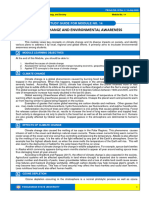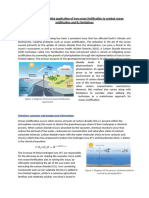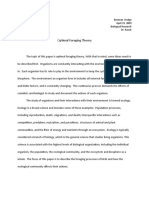Cloud Seeding and Ocean Acidification
Cloud Seeding and Ocean Acidification
Uploaded by
Vijay Kumar KalakadaCopyright:
Available Formats
Cloud Seeding and Ocean Acidification
Cloud Seeding and Ocean Acidification
Uploaded by
Vijay Kumar KalakadaOriginal Title
Copyright
Available Formats
Share this document
Did you find this document useful?
Is this content inappropriate?
Copyright:
Available Formats
Cloud Seeding and Ocean Acidification
Cloud Seeding and Ocean Acidification
Uploaded by
Vijay Kumar KalakadaCopyright:
Available Formats
GEOGRAPHY
MODULE-5
CLOUD SEEDING & OCEAN ACIDIFICATION
Cloud seeding is an artificial way of weather modification, a way of changing the
amount or type of precipitation that falls from clouds. It is done by dispersing
substances into the air that serve as cloud condensation nuclei.
CHEMICALS USED
Silver iodide, dry ice (solid carbon dioxide), Liquid propane, table salt etc.
Two processes of cloud seeding:
Hygroscopic Seeding: To get rainfall.
Glaciogenic Seeding: To get snowfall or hail.
APPLICATIONS
AGRICULTURE
Inducing cloud to precipitate and break dry spell helps manage sowing and
prevent crop wilting.
DISASTER MITIGATION
o Glaciogenic techniques can be used to reduce size of hail stones and check
crop loss.
o By modifying precipitation, cloud seeding can be used to prevent both droughts
and floods.
NEO IAS 0484-4030104, 9446331522, 9446334122 Page 1
www.neoias.com | www.youtube.com/neoias | www.facebook.com/neoias | www.twitter.com/neoias
EVENT MANAGEMENT
During the 2008 Summer Olympics in Beijing, clouds were seeded using rockets,
so that there would be no rain during the opening and closing ceremonies.
REJUVENATING GLACIERS
Glaciogenic techniques can help restore the mass of depleting glaciers.
POLLUTION
Fog and smog, which elevates air pollution, can easily be cleared by glaciogenic
seeding.
CONS OF CLOUD SEEDING
• It uses potentially harmful chemicals. Cloud seeding involves the use of
chemicals into the air, which means that it can potentially harm the environment,
especially plants and animals. However, the complete effect of cloud seeding on
the environment is not fully known yet. Though silver iodine is not currently known
to be harmful to our health today, but it might change in the future as more research
is done and completed.
• It can lead undesirable weather problems. Once the silver iodine and other
chemicals are released into the atmosphere, there is no controlling of what type
of weather would form. It is likely that there will be too much rain, which can cause
the problem of flooding.
• High investments are associated with cloud seeding making it unsustainable.
• It is not a ‘proven technology’ and its success is dependent on several climatic
variables. Thus it needs to be properly studied before applying on large scale.
CLOUD SEEDING IN INDIA
Experiments conducted by the Indian Institute of Tropical Meteorology in Pune
reported to show an indication of 24 per cent enhancement in precipitation in
targeted areas.
A ₹250-crore programme, coordinated by the Indian Institute of Tropical
Meteorology, during 2017 monsoon in Maharashtra to combat drought.
NEO IAS 0484-4030104, 9446331522, 9446334122 Page 2
www.neoias.com | www.youtube.com/neoias | www.facebook.com/neoias | www.twitter.com/neoias
OCEAN ACIDIFICATION
Ocean acidification is the process of decrease in the pH of the Earth's oceans, caused
by the uptake of carbon dioxide (CO2) from the atmosphere.
Since the beginning of the Industrial Revolution, the pH of surface ocean waters has
fallen by 0.1 pH units. Since the pH scale, like the Richter scale, is logarithmic, this
change represents approximately a 30 percent increase in acidity.
For tens of millions of years, Earth's oceans have maintained a relatively stable
acidity level. It's within this steady environment that the rich and varied web of life
in today's seas has arisen and flourished. But research shows that this ancient
balance is being undone by a recent and rapid drop in surface pH that could have
devastating global consequences.
CAUSES
Half of the anthropogenic CO2, resulting from burning of fossil fuels, has been
absorbed over time by the oceans. When carbon dioxide dissolves in this ocean,
carbonic acid is formed. This leads to higher acidity, mainly near the surface,
which has been proven to inhibit shell growth in marine animals and is suspected
as a cause of reproductive disorders in some fish.
Surface run-off
Release of carbon trapped in polar regions
NEO IAS 0484-4030104, 9446331522, 9446334122 Page 3
www.neoias.com | www.youtube.com/neoias | www.facebook.com/neoias | www.twitter.com/neoias
IMPACTS
• Shell-forming animals including corals, oysters, shrimp, lobster, many planktonic
organisms, and even some fish species could be gravely affected.
• As the oceans continue to absorb more CO2, their capacity as a carbon
storehouse could diminish. That means more of the carbon dioxide we emit will
remain in the atmosphere, further aggravating global climate change.
• Photosynthetic algae and seagrasses may benefit from higher CO2 conditions in
the ocean, as they require CO2 to live just like plants on land.
• Many chemical reactions, including those that are essential for life, are sensitive
to small changes in pH. A small change in the pH of seawater can have harmful
effects on marine life, impacting chemical communication, reproduction, and
growth.
• Since sustained efforts to monitor ocean acidification worldwide are only
beginning, it is currently impossible to predict exactly how ocean acidification
impacts will cascade throughout the marine food chain and affect the overall
structure of marine ecosystems.
CONCLUSION
Scientific awareness of ocean acidification is relatively recent, and researchers are just
beginning to study its effects on marine ecosystems. But all signs indicate that unless
humans are able to control and eventually eliminate our fossil fuel emissions, ocean
organisms will find themselves under increasing pressure to adapt to their habitat's
changing chemistry or perish.
NEO IAS 0484-4030104, 9446331522, 9446334122 Page 4
www.neoias.com | www.youtube.com/neoias | www.facebook.com/neoias | www.twitter.com/neoias
You might also like
- Saes R 004Document8 pagesSaes R 004nadeem shaikh100% (1)
- Air Circuit Breakers: CG International DivisionDocument9 pagesAir Circuit Breakers: CG International DivisionHari Krishna.M100% (2)
- STS Report Climate ChangeDocument41 pagesSTS Report Climate ChangeEvelyn Guevarra100% (1)
- No. 6 Ocean Acidification Foresight ReportDocument98 pagesNo. 6 Ocean Acidification Foresight ReportHerbert BillNo ratings yet
- Ocean Acidification PHD ThesisDocument13 pagesOcean Acidification PHD ThesisPayToDoPaperUK100% (2)
- Socio RP Sem 3Document17 pagesSocio RP Sem 3Akshat MishraNo ratings yet
- STS Final Scope M. OlarteDocument7 pagesSTS Final Scope M. OlarteGlenn RadisNo ratings yet
- TitleDocument2 pagesTitledaniel holmesNo ratings yet
- Rise in Sea Bed and International Environment LawDocument5 pagesRise in Sea Bed and International Environment LawHarshini PrakashNo ratings yet
- Note About Climate ChangeDocument24 pagesNote About Climate ChangedorianfourdinierNo ratings yet
- Climate Change and Environmental Awareness: Study Guide For Module No. 14Document3 pagesClimate Change and Environmental Awareness: Study Guide For Module No. 14Maylene CalicdanNo ratings yet
- SG 14Document3 pagesSG 14Elvin Jun BugayongNo ratings yet
- Ocean AcidificationDocument26 pagesOcean AcidificationJosé Carlos da SilvaNo ratings yet
- Kuliah 3 Waste Stabilization Ponds and LagoonsDocument26 pagesKuliah 3 Waste Stabilization Ponds and LagoonsHafizhul HidayatNo ratings yet
- Carbon Sequestration: Dr. (Prof.) Anjana SharmaDocument40 pagesCarbon Sequestration: Dr. (Prof.) Anjana SharmaPallavi NandiNo ratings yet
- Ocean AcidificationDocument16 pagesOcean AcidificationAli SabriNo ratings yet
- AdwaithaDocument18 pagesAdwaithaSwattick ChakrabortyNo ratings yet
- OA20Facts NovDocument2 pagesOA20Facts NovDongsipoi HuynhNo ratings yet
- The Impact of Climate Change On Coral ReefsDocument2 pagesThe Impact of Climate Change On Coral ReefsJaySidka73No ratings yet
- insightsonindia.com-Polar Ice melt Impact on Monsoon Patterns and economyDocument5 pagesinsightsonindia.com-Polar Ice melt Impact on Monsoon Patterns and economysupravatdey203No ratings yet
- Global Warming and Environment Pollution by Paint IndustryDocument46 pagesGlobal Warming and Environment Pollution by Paint IndustryVikas kumarNo ratings yet
- Climate Change and Associated Issues - InsightsiasDocument50 pagesClimate Change and Associated Issues - InsightsiasKaranNo ratings yet
- Title of The Research Climate Change andDocument8 pagesTitle of The Research Climate Change andcharlie malinaoNo ratings yet
- Ecology Project g13 ReportDocument11 pagesEcology Project g13 ReportgamingdheerubhaiNo ratings yet
- CSTC NSTP Lesson 6 Environmental Awareness PDFDocument16 pagesCSTC NSTP Lesson 6 Environmental Awareness PDFRochelle Obdianela De CastroNo ratings yet
- EST_REPORT_FDocument20 pagesEST_REPORT_FAkash KhurdNo ratings yet
- A Comprehensive study of the IPCC'S 2023 climate change reportDocument9 pagesA Comprehensive study of the IPCC'S 2023 climate change reportsadideen176No ratings yet
- Ocean Acidification - Ashwin ShajithDocument18 pagesOcean Acidification - Ashwin ShajithAshwin ShajithNo ratings yet
- Climate Change Impact Fisheries MalaysiaDocument31 pagesClimate Change Impact Fisheries MalaysiaWan Luqman Wan RosdiNo ratings yet
- Great Barrier Reef Suffering Fifth Mass Coral Bleaching in Eight YearsDocument9 pagesGreat Barrier Reef Suffering Fifth Mass Coral Bleaching in Eight YearsHim AnshNo ratings yet
- Ocean Conservation in A High CO2 World: The Need To Evaluate New ApproachesDocument6 pagesOcean Conservation in A High CO2 World: The Need To Evaluate New ApproachesMelissa Patiño PérezNo ratings yet
- 1 s2.0 S0048969723071991 MainDocument8 pages1 s2.0 S0048969723071991 Mainqinglin1596433No ratings yet
- Groundwater Quality Analysis in Dry Seasons in PanDocument9 pagesGroundwater Quality Analysis in Dry Seasons in PanayocobatebakNo ratings yet
- Sea Level Change (v1)Document6 pagesSea Level Change (v1)ayush112121008No ratings yet
- JETIR1805785Document5 pagesJETIR1805785Sagar GaikwadNo ratings yet
- climatedisruptionGOESDocument24 pagesclimatedisruptionGOESIvana StojnicNo ratings yet
- L3 Case Study - Ocean AcidificationDocument19 pagesL3 Case Study - Ocean AcidificationAakash YadavNo ratings yet
- The Impact of Climate Change On WaterDocument4 pagesThe Impact of Climate Change On Waterkizito olewuikeNo ratings yet
- Climate Change 101Document35 pagesClimate Change 101Netflix OneNo ratings yet
- Activity No. 6 In: Environmental ScienceDocument7 pagesActivity No. 6 In: Environmental ScienceJosiah Samuel EspanaNo ratings yet
- 16.1, 16.3 and 16.4 PDFDocument28 pages16.1, 16.3 and 16.4 PDF....No ratings yet
- Ocean Acidification 1Document10 pagesOcean Acidification 1Mansi BansodNo ratings yet
- Ocean Pollution and SolutionDocument8 pagesOcean Pollution and Solutionhamzaansari2728No ratings yet
- Global WarmingDocument6 pagesGlobal WarmingrabiahadawiyahNo ratings yet
- 2nd Lesson WeatherDocument62 pages2nd Lesson WeatherDenver De CastilloNo ratings yet
- CHEM She TaskDocument4 pagesCHEM She Taskkashishparis2007No ratings yet
- NSTP Report FinalDocument23 pagesNSTP Report FinalDwight AlipioNo ratings yet
- The Effects of Climate Change On Coral ReefsDocument4 pagesThe Effects of Climate Change On Coral ReefswizardlyboseNo ratings yet
- BIO 320 Carbon SinkDocument10 pagesBIO 320 Carbon SinkCourtney19100% (1)
- Term Paper About Marine PollutionDocument6 pagesTerm Paper About Marine Pollutionea4hasyw100% (1)
- Epm - M 1Document23 pagesEpm - M 1Supreeth SPNo ratings yet
- IAP StatementDocument3 pagesIAP Statementhrhr99No ratings yet
- 1940 - F23 - L20 - Climate Change - 2Document35 pages1940 - F23 - L20 - Climate Change - 2ashwingupta88077No ratings yet
- Vision VAM 2020 (Essay) Climate ChangeDocument14 pagesVision VAM 2020 (Essay) Climate ChangeGaurang Pratap SinghNo ratings yet
- Sat TiDocument12 pagesSat TiHumane JoneyNo ratings yet
- WATER AN ENVIRONMATAL ISSUE - SuyashDocument10 pagesWATER AN ENVIRONMATAL ISSUE - SuyashSuyashNo ratings yet
- Ijsrp p8791Document6 pagesIjsrp p8791madiihahNo ratings yet
- BRIX MHEIR I. FELICIANO 1-G 2nd Pre-Final QuizDocument7 pagesBRIX MHEIR I. FELICIANO 1-G 2nd Pre-Final QuizBrix FelicianoNo ratings yet
- Climate ChangeDocument37 pagesClimate ChangelipibhaiNo ratings yet
- Environment LawDocument3 pagesEnvironment LawAkiNo ratings yet
- Divine WorkDocument31 pagesDivine WorkchinweokwumartinsNo ratings yet
- Chapter 6 - Duel For North AmericaDocument22 pagesChapter 6 - Duel For North AmericakgbaburajNo ratings yet
- Lesson Plan Full - TheoryDocument7 pagesLesson Plan Full - TheoryNur Izzati AdamNo ratings yet
- Optimal Foraging TheoryDocument9 pagesOptimal Foraging TheoryBrennen Hodge100% (1)
- Communication English ProjectsDocument12 pagesCommunication English Projectsroyalq392No ratings yet
- Chapter 1Document81 pagesChapter 1Biniyamin IndrisNo ratings yet
- Augmentin DdsDocument12 pagesAugmentin DdsQureshi imtiyazNo ratings yet
- Pseudo CityDocument127 pagesPseudo CityJosue Cristian MelisNo ratings yet
- Soldering Procedure Qualification Record (SPQR) - Sample FormDocument2 pagesSoldering Procedure Qualification Record (SPQR) - Sample FormBernardo LeorNo ratings yet
- Machine Tools Lab ManualDocument51 pagesMachine Tools Lab ManualCharan KumarNo ratings yet
- Design, Fabrication and Testing of Friction Stir Welded JointsDocument8 pagesDesign, Fabrication and Testing of Friction Stir Welded JointsParshotam SharmaNo ratings yet
- Gdi Mussel Presentation 11Document37 pagesGdi Mussel Presentation 11yesim53No ratings yet
- Brahma and Abraham: Part I - Divine Covenants of Common OriginDocument22 pagesBrahma and Abraham: Part I - Divine Covenants of Common OriginFindingTurtleIslandNo ratings yet
- Traoré Et Al. - 2009 - Dust Explosions How Should The Influence of Humidity Be Taken Into Account-AnnotatedDocument7 pagesTraoré Et Al. - 2009 - Dust Explosions How Should The Influence of Humidity Be Taken Into Account-AnnotatedDr. Khan MuhammadNo ratings yet
- VHF Repeater Combining Systems 136 - 174 MHZ: Rtc15 SeriesDocument2 pagesVHF Repeater Combining Systems 136 - 174 MHZ: Rtc15 SeriesBao Quoc MaiNo ratings yet
- 12 Panel 3 Yoram AvnimelechDocument33 pages12 Panel 3 Yoram AvnimelechAnonymous dnQEPoumuzNo ratings yet
- SikaPlast-518 (Ro) SDS - ENGDocument10 pagesSikaPlast-518 (Ro) SDS - ENGmuzafferkeskin2020No ratings yet
- An Introduction To The Human BodyDocument41 pagesAn Introduction To The Human Bodyazizirabia5No ratings yet
- Bachelor Thesis 302511Document70 pagesBachelor Thesis 302511s kNo ratings yet
- Curriculum Vitae - DR ItaDocument2 pagesCurriculum Vitae - DR ItaZoel NikonianNo ratings yet
- Diabetes Pharmacotherapy Clinic GuidelinesDocument41 pagesDiabetes Pharmacotherapy Clinic GuidelinesAbo-ahmed ElmasryNo ratings yet
- Dani Mechanism CHAPTER 1Document36 pagesDani Mechanism CHAPTER 1daniel hambissaNo ratings yet
- Arar Ups SizingDocument6 pagesArar Ups Sizingsrigirisetty208No ratings yet
- EndocarditisDocument27 pagesEndocarditisruchikakaushal1910No ratings yet
- Classification of IndustriesDocument10 pagesClassification of Industriesbba2024gietu100% (7)
- Dream Divers February 2009 NewsletterDocument4 pagesDream Divers February 2009 NewsletterDream DiversNo ratings yet
- Scalar and Vector-Valued Fragility Analysis of Typical Algerian RC Bridge PiersDocument14 pagesScalar and Vector-Valued Fragility Analysis of Typical Algerian RC Bridge PiersViewingFreePDFSShouldNotBeChargedFuckYouSCRIBDNo ratings yet
- HarmonicDocument18 pagesHarmonicShahbaz QamarNo ratings yet
- Hydraulics - Formulae For Partially Filled Circular Pipes (Akgiray, 2004) PDFDocument15 pagesHydraulics - Formulae For Partially Filled Circular Pipes (Akgiray, 2004) PDFRavi KumarNo ratings yet

























































































